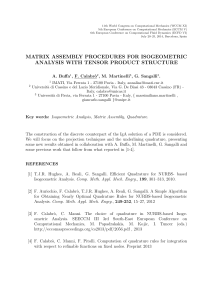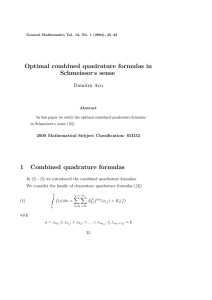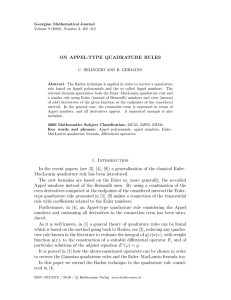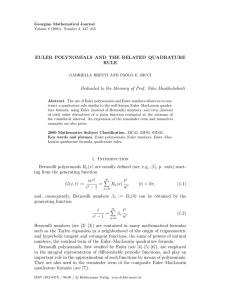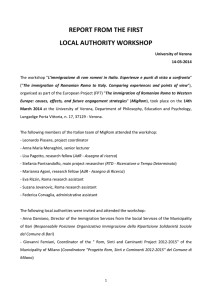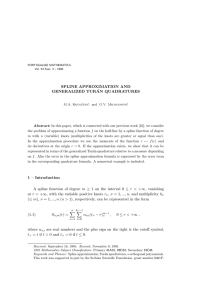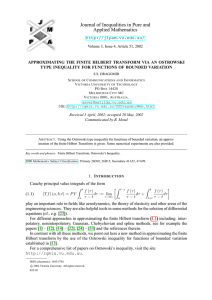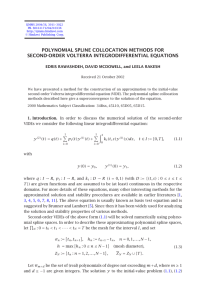On the Tricomi s quadrature formula Dumitru Acu
advertisement
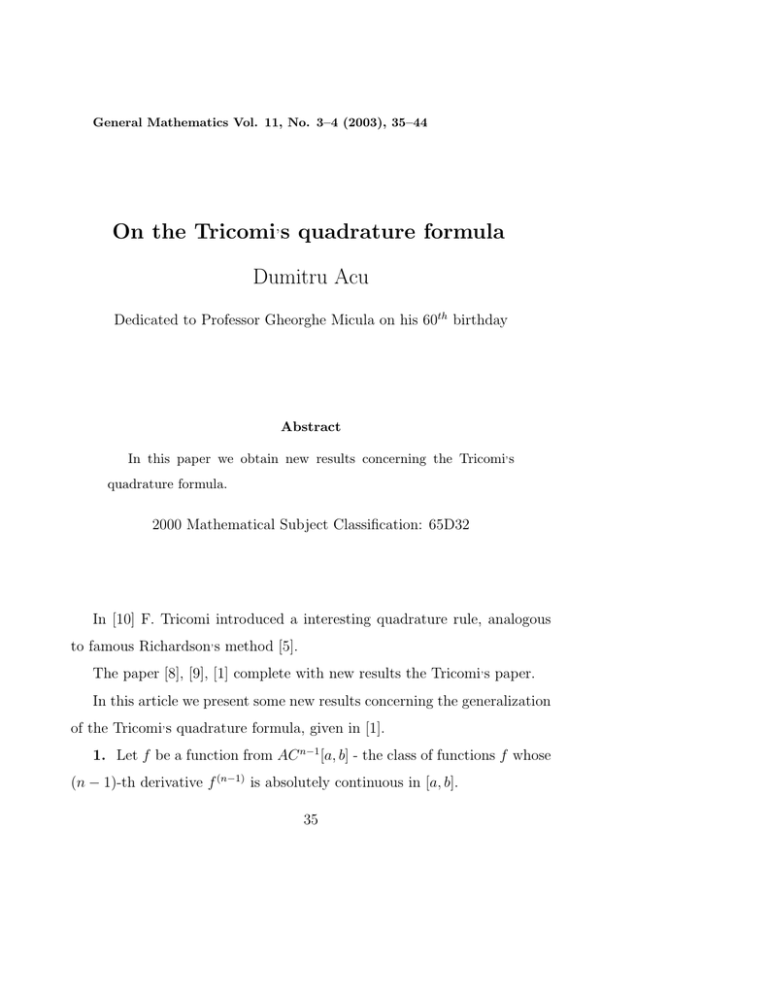
General Mathematics Vol. 11, No. 3–4 (2003), 35–44 On the Tricomi,s quadrature formula Dumitru Acu Dedicated to Professor Gheorghe Micula on his 60th birthday Abstract In this paper we obtain new results concerning the Tricomi, s quadrature formula. 2000 Mathematical Subject Classification: 65D32 In [10] F. Tricomi introduced a interesting quadrature rule, analogous to famous Richardson, s method [5]. The paper [8], [9], [1] complete with new results the Tricomi, s paper. In this article we present some new results concerning the generalization of the Tricomi, s quadrature formula, given in [1]. 1. Let f be a function from AC n−1 [a, b] - the class of functions f whose (n − 1)-th derivative f (n−1) is absolutely continuous in [a, b]. 35 36 Dumitru Acu We consider the elementary quadrature formula Zb (1) f (x)dx = n−1 X m X (k) Aki f(xi ) + R(f ), k=0 i=1 a with the algebraical degree of exactness n − 1 and with the remainder given by Zb (2) R(f ) = (n) f(ξ) φ(x)dx, ξ ∈ (a, b), a where φ is the influence function ([7]). We divide the interval [a, b] into a certain number p partial intervals [uj−1 , uj ], j = 1, p, defined by the points (3) a = u0 < u1 < ... < up−1 < up = b and we put dj = uj − uj−1 , j = 1, p. We evaluate the integral Zb I= f (x)dx, a using the generalized quadrature formula generated to the elementary formula (1) (see [7]). We obtain (4) with (5) I = Sp + Rp ¶k+1 µ ¶ p n−1 m µ X XX dj xj − a (k) Aki f uj−1 + dj Sp = b−a b−a j=1 k=0 i=1 and the remainder (6) ¶n+1 # p µ X dj (n) f(ξ1 ) , ξ1 ∈ [a, b), Rp = T b−a j=1 " On the Tricomi, s quadrature formula where 37 Zb (7) T = φ(x)dx. a Now we divide the interval [a, b] into a certain number q, q > p, partial intervals [vj−1 , vj ], j = 1, q, defined by the points (8) a = v0 < v1 < ... < vq−1 < vq = b, with cj = vj − vj−1 , j = 1, q. We evaluate the integral I using the generalized quadrature formula generated to the elementary formula (1) and the partition (8). We find: (9) I = Sq + Rq , with (10) ¶k+1 µ ¶ q n−1 m µ X XX cj xi − a (k) Sq = Aki f vj−1 + cj b−a b−a j=1 k=0 i=1 and the remainder (11) " q µ ¶n+1 # X cj Rq = T f (n) (ξ2 ), ξ2 ∈ (a, b). b − a j=1 If the function f is a polynomial of degree ≤ n, then f (n) (ξ1 ) = f (n) (ξ2 ). In this situation, if we put µ ¶n+1 p P dj D= b−a j=1 (12) and ´ p ³ P cj n+1 C= , b−a j=1 then from (4), (6), (9), (11) it results (13) T f (n) (ξ1 ) = T f (n) (ξ2 ) = Sq − Sp . D−C 38 Dumitru Acu Using (9), (11) şi (13), we get tn (Sq − Sp ), I = Sq + 1 − tn (14) where t = p n C/D. Now, for an arbitrary function f ∈ AC n−1 [a, b], we consider the quadarture formula (15) I = Sq + tn (Sq − Sp ) + Rp,q , 1 − tn where Sq , Sp and t are the above. From (15), (4) and (9), we have Rp,q = 1 (Rq − tn Rp ), 1 − tn whence, using (6) and (11), we find the following forms for the remainder of the formula (15): (16) Rp,q = TC (n) (n) n [f(ξ2 ) − f(ξ1 ) ], 1−t (17) Rp,q = T Dtn (n) (n) [f − f(ξ1 ) ], 1 − tn (ξ2 ) (18) Rp,q = T CD (n) (n) [f(ξ2 ) − f(ξ1 ) ], D−C ξ1 , ξ2 ∈ (a, b) In view of (16), (17) and (18), it results |T |C (n) Ω , 1 − tn (19) |Rp,q | ≤ (20) |T |Dtn (n) Ω , |Rp,q | ≤ 1 − tn On the Tricomi, s quadrature formula (21) |Rp,q | ≤ 39 |T |CD n Ω , D−C where Ω(n) is the oscillation of the function f (n) on [a, b]. If we take into account that for T usually have a relation by form Zb φ(x)dx| = |α||b − a|n+1 , |T | = | a where α is a constant, then from (9) - (21), we have à p ! X |α| Cjn+1 Ω(n) (22) j=1 |Rp,q | ≤ à |α| (23) (24) |Rp,q | ≤ p X à p X j=1 dn+1 Ω(n) j dn+1 j 1 − tn !à q X j=1 p X ! j=1 |Rp,q | ≤ |α| , 1 − tn dn+1 − j , ! Cjn+1 j=1 n X cn+1 j j=1 · Ω(n) . 2. Particular cases. 2.1 If we consider a d = d2 = ... = db = b − p = ωp 1 (25) and c = c = ... = c = b − a = ω , 1 2 q q q then t = p/q. 40 Dumitru Acu In this case, the formula (15) presents a generalization of the results from [8] for the quadrature formulas which they contain the values of the derivative the function f on the nodes. For the remainder, from (23) we found (26) |Rp,q | ≤ |α|pωpn+1 tn (n) . nΩ 1−t For q = 2p we obtain a generalization of the Tricomi, s results. 2.2 If (25) are satisfied and the elementary quadrature formula (1) contains only the values of the function f on the nodes, then (15) and (22) - (24) give the results by [8]. For q = 2p we obtain the Tricomi, s results ([10]). Examples. In this section we present some examples of quadrature formula by Tricomi, s type obtained by the particularizing of the elementary rule (1). 3.1. Assume that (1) is the rectangular formula ([7]). We find the following Tricomi, s quadrature formula: I = Sq + with Sp = p X t2 (Sq − Sp ) + Rp,q 1 − t2 dj (a + d1 + d2 + ... + dj−1 + j=1 Sq = q X cj (a + c1 + c2 + ... + cj−1 + j=1 và ! ! à q u q X u X d3 , c3 / t=t j j j=1 j=1 dj ), 2 cj ), 2 On the Tricomi, s quadrature formula 1 |Rp,q | ≤ 24 à p X 41 ! d3j t2 Ω(2) , 1 − t2 · j=1 where Ω(2) is the oscillation of the function f 00 on [a, b]. a From here, for d1 = ... = dp = b − a = ωp , c1 = c2 = ... = cq = b − q = ωq b we find the results by [8]. 3.2 We consider (1) the Simpson, s formula. It results the following Tricomi, s quadrature formula I = Sq + with t4 (Sq − Sp ) + Rp,q , 1 − t4 p−1 X dj + dj+1 dj Sp = f (a) + (a + d1 + ... + dj )+ 2 6 j=1 µ ¶ p X 2dj dj dp + f a + d1 + ... + dj−1 + + f (b), 3 3 6 j=1 q−1 X cj + cj+1 c1 f (a + c1 + ... + cj ) + Sq = f (a) + 6 6 j=1 q X 2cj ³ cj ´ Cq + f a + c1 + ... + cj+1 + + f (b), 3 3 6 j=1 và ! à p ! u q X u X 4 t=t c5j / d5j , j=1 |Rp,q | ≤ j=1 j=1 ! d5j t4 (4) 4Ω , 1−t is the oscillation of the function f (4) on [a, b]. − a = 2ω and c = c = ... = From here, for d1 = d2 = ... = dp = 2 b 2p 2p 1 2 2(b − a) cq = 2q , we obtain the results by [8]. If q = 2p then we find the case studied by Tricomi, s ([10]). where Ω (4) 1 2880 à p X 42 Dumitru Acu 3.3. Finally, we assume that (1) is Newton, s quadrature formula ([2], [3]). We obtain the following Tricomi, s quadrature formula: I = Sq + with t4 (Sq − Sp ) + Rp,q 1 − t4 p−1 X dj + dj+1 di Sp = f (a) + f (a + d1 + ... + dj )+ 8 8 j=1 p X 3dj dp + f (b) + f 8 8 j=1 µ dj a + d1 + ... + dj−1 + 3 ¶ + µ ¶ p X 3dj 2dj + , f a + d1 + ... + dj−1 + 8 3 j=1 q−1 X cj + cj+1 ci Sq = f (a) + f (a + c1 + ... + cj )+ 8 8 j=1 X 3cj ³ cj ´ cq + f a + c1 + ... + cj−1 + + f (b) + 8 8 3 j=1 q µ ¶ q X 3cj 2cj + f a + c1 + ... + cj−1 + , 8 3 j=1 và ! à p ! u q X u X 4 t=t c5j / d5j , j=1 1 |Rp,q | ≤ 6480 à j=1 p X j=1 ! d5j t4 (4) 4Ω , 1−t where Ω(4) is the oscillation of the function f (4) on the [a, b]. On the Tricomi, s quadrature formula 43 References [1] Acu, D., Generalizarea procedeului de integrare numerică a lui Tricomi, Buletinul Ştiinţific al Institutului de Învăţământ Superior din Sibiu, Serie tab. mat., vol. VI, 1982, 3 - 6 (in Romanian). [2] Acu, D., Formule combinate de cuadratură, Studia Univ. Babeş Bolyai, Mathematica, XXVI, 3, 1981, 6 - 12, (in Romanian). [3] Acu, D., O generalizare a formulei de quadratură a lui Newton, St. Cerc. Mat., 23, 1971, 1003 - 1008, (in Romanian). [4] Acu, D., O formulă combinată de cuadratură, St. Cerc. Mat., 24, 3, 1972, 317 - 324 (in Romanian). [5] Coman, Gh., O generalizare a formulei de cuadratură a trapezelor şi a formulei lui Simpson, Studia Univ. Babeş - Bolyai, ser. Math. Phys., 14, 2, 1969, 53 - 58 (in Romanian). [6] Engels, H., Numerical Quadrature and Cubature, Academic Press, 1980 [7] Ghizzetti, A., Ossicioni, A., Quadrature formulae, Acad.-Verlag-Berlin, 1970 [8] Iacob, A., Generalizarea unor formule de cuadratură a lui Tricomi, St. Cerc. Mat., 17, 8, 1965, 1221 - 1230 (in Romanian). [9] Micula, M., Micula, Gh., Sur la formule de quadrature de la Tricomi, Bull. Math. de la Soc. Sci. Math. de la R.S.R., 12 (160), 1968, 95 - 105 (in Romanian). 44 Dumitru Acu [10] Tricomi, F., Sul resto delle formule di quadrature numerica migliorate con metode “extrapolazione”, Boll. dell Unione Math. Ital., 3, 14, 1959, 102 - 104 (in Romanian). Department of Mathematics “Lucian Blaga” University of Sibiu Str. Dr. I. Raţiu, nr. 5-7 550012 Sibiu, Romania. E-mail address: depmath@ulbsibiu.ro
